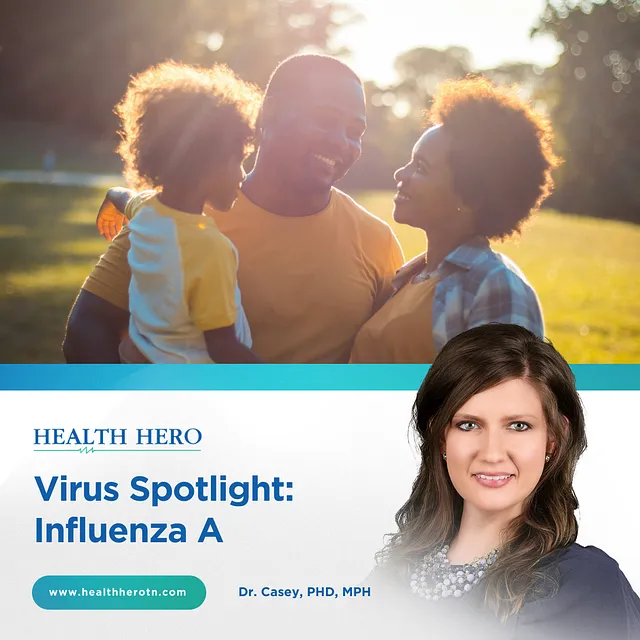In one of my most recent posts, I talked about the differences between the major viruses that have been affecting the U.S. this season (the “quademic,” as some have dubbed it): influenza, COVID-19, RSV, and norovirus. Today, though, I want to focus special attention on one of these that has had a particularly notable surge across the country lately, reaching some of the highest levels we use to measure activity. I do not think it will come as a surprise that I am talking about the influenza A virus. I have received several questions and comments about influenza A recently, likely due to these increased levels, so I will answer as many of those as I can (and more) in today’s post.
Some basics about influenza viruses
Just for some background, I will give you a little information about types of influenza, so you can get a better understanding of influenza A. There are four types of influenza viruses: A, B, C, D. Influenzas A, B, and C can affect humans, while influenza D mainly affects animals (such as cattle). Even though influenza C can infect humans, it is much less common and typically causes milder illnesses than A and B. The ones we are most interested in, because they affect us most significantly, are types A and B.
Influenza A and B are the most common, and are the types of influenza that cause “flu season” almost every winter in the U.S. “Flu season” is actually a seasonal epidemic of disease. Influenza A is the only type of influenza known to cause flu pandemics. Influenza A viruses are classified into different types based on two proteins found on the virus’s surface. The first is hemagglutinin (H) and the other is neuraminidase (N). Each of these has multiple subtypes, and that is how different types of influenza A are named, as we sometimes read and hear about (for example, H1N1). These subtypes can be broken down even further, becoming even more detailed and specific, but instead of getting into Virology 101, I will post a resource below if you are interested in getting into the more intricate processes of this.
Why are we concerned right now in the U.S.?
The flu continues to surge all over the U.S., and the majority of these flu cases are influenza A. Another concern is that influenza A usually causes worse symptoms compared to influenza B, and patients with influenza A are more likely to get hospitalized. Influenza B can definitely be severe, too, but right now, influenza A is what is sweeping the nation. In fact, of all the flu tests that have been reported to the Centers for Disease Control and Prevention (CDC) since flu season started last fall, approximately 97% have been positive for influenza A.
This year’s flu season has reached unusually high levels compared to recent years. Currently, we are in what is considered a “second wave” of flu, which is common after the holidays when many people gather in small settings, frequently offering the opportunity for greater viral spread. Figures from the CDC show that national levels of influenza are currently the highest they have been since the peak of the 2009 swine flu pandemic (link below to the website with the figures and other data you can look at). However, the high rates this season are not from a new strain like in 2009. Rather, these high rates seem to be from the usual seasonal types of the influenza virus.
According to the CDC (and a helpful map to which I will also post a link below), most states are at “high” or “very high” levels of influenza. This is based on the most recent data which is from the week ending February 1, 2025. While some states may have reached their peak of flu, others are still growing, and unfortunately, there is not much we can do in the way of predicting how these trends with go.
Why are flu levels so high this year?
Many things can influence overall high levels of flu. One major contributor is that the CDC reports that flu vaccination rates among children are the lowest they have been in six years. Children, particularly, with more vulnerable immune systems, are often infected more easily than adults, and then attend schools which are a prime breeding ground to share germs and spread viruses. In fact, many schools throughout the country have briefly closed to try to stop the cycle of viral spreading among students, faculty/staff, and families. Also, this year, less than half of American adults have received a flu vaccination, making these individuals more susceptible to being infected by flu viruses and for those flu viruses to be more severe.
For example, as time has passed since the COVID-19 pandemic, many people have become more relaxed in their prevention practices. Far fewer people are wearing masks; quarantining or even just staying home from work or school when feeling sick has become an outdated idea for many people, and fewer people are as vigilant about washing their hands, using hand sanitizer, and disinfecting surfaces regularly. People also feel much more comfortable being in large crowds again, as well as in enclosed spaces lacking much ventilation. Many of us feel like life is, “back to normal,” meaning — like it was before COVID-19. But we need to remember that while we no longer have to live in the strict conditions of the pandemic, we need to adopt a new normal, in which we find a balance or compromise between our old ways and the rigid pandemic standards.
Other Questions?
I hope this helps with understanding more about the major flu surges going on around the U.S. right now, and gives you some ways to protect yourself from these viruses. Even if you have had the flu once this season, you can get it again, so do not think you are in the clear. And it is important to take all the prevention steps we can to protect both ourselves and all of those around us. If you can, try to spend some time thinking about the middle ground of the new normal I mentioned above. Maybe even talk about it with others. It is going to be very important going forward to keeping all of us safe and healthy. As always, your questions and comments are welcome, as well as topic suggestions if you have anything in particular you would like to read more about. I am particularly excited about my next piece, so stay tuned! Thank you all, and take care.
Be Well; Be Kind,
Dr. Casey
Want to Learn More?
Can’t get enough about how influenza viruses are broken down into even more detailed subtypes, lineages, and more? Learn more at this CDC site:
https://www.cdc.gov/flu/about/viruses-types.html
The CDC posts a Weekly Influenza Surveillance Report, and one part of it is a Weekly US Map of an Influenza Summary Update. This shows “Influenza Like Illness” Activity Level per state and tracks how it changes by week:
https://www.cdc.gov/fluview/surveillance/usmap.html
The CDC also posts Weekly Influenza Surveillance Report “Key Updates” each week, with the most recent report from the week ending February 1, 2025 (it takes a while to collect and process data from the entire nation so there is a lag time). You can look at these key updates here:
https://www.cdc.gov/fluview/surveillance/2025-week-05.html
Here is a great article that talks about this year’s intense flu season and the impact it has had on many states and communities:
https://www.pbs.org/newshour/health/u-s-facing-most-intense-flu-season-in-at-least-15-years
In case anyone needs a refresher on what symptoms to be on the lookout for when it comes to the flu, here is a tidy list to refer to:


